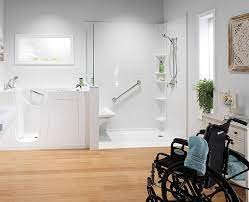Modern Design Principles in Accessible Showers
Bathroom design is transforming as accessibility becomes a top priority for homeowners and designers. A truly accessible shower prioritizes user comfort and safety without creating a clinical environment. Newer designs incorporate features like the luxury walk-in shower installation, eliminating high steps and offering a generous, open entry. This design not only benefits wheelchair users or people with limited mobility but also enhances convenience for children, older adults, and anyone seeking a safer daily routine. The goal is to create a barrier-free space that allows everyone to experience independence and ease while showering.
Design professionals focus on light-filled layouts, clear sight lines, and seamless transitions between the shower and the rest of the bathroom. Attention to detail in layout planning ensures that showers feel inviting and spacious, removing the stigma that accessibility has to look institutional. As more families plan for aging in place, these inclusive features are increasingly valued for their long-term versatility and comfort.
Low-Threshold Entry and Barrier-Free Access
The hallmark of an accessible shower is a low or zero-threshold entry. This design eliminates the traditional step or curb, enabling easy entry for wheelchair users and reducing tripping hazards for everyone. Sloping the shower floor toward a central or linear drain allows water containment to be managed efficiently, even with no visible barrier. This curbless setup works beautifully with open-plan bathrooms, often making the space look larger and more elegant.
Barrier-free showers have gained popularity across global markets because of their user-centric design. They’re not just for individuals with disabilities: parents carrying babies or anyone with joint pain can appreciate the safety and freedom of movement. Designers recommend pairing this entry type with wider doors and unobstructed turning radii to increase accessibility and comfort for all users.
Safe, Non-Slip Surfaces and Flooring
Flooring is one of the most critical safety considerations in any accessible shower. High-quality, non-slip surfaces help prevent slips and falls, a leading cause of injury in home bathrooms. Porcelain, textured ceramic tiles, and specially engineered vinyl floors are favorite choices for safety and aesthetics. Modern trends include large-format tiles with minimal grout lines for easier maintenance and a sleeker appearance.
Many designs include slip-resistant coatings or mats that blend with the overall look for added protection. According to architectural creativity, contrasting colors on the floor can be used to guide visually impaired individuals and add a distinctive design touch. Prioritizing safety in flooring helps everyone maintain their dignity and self-reliance in the bathroom.
Shower Fixtures Designed for Accessibility
Fixtures play a central role in making showers truly accessible. Handheld showerheads with adjustable heights, lever-operated mixing valves, and easy-to-grip controls provide flexibility for different users and abilities. The showerhead’s placement—either wall-mounted or on a sliding rail—can be customized for those who prefer to be seated or remain standing while showering.
Thoughtful design also means locating shelves, soap dishes, and niche storage at comfortable heights. Tilted, anti-fog mirrors or fold-down seats further increase user comfort and safety, supporting those with strength or balance limitations. These features are easy to incorporate during initial construction or as part of an upgrade, giving showers lasting accessibility value.
Smart Storage and Supportive Accessories
Accessible showers include more than safe entry and durable fixtures—they are personalized spaces with considered storage and support. Grab bars, for example, are essential, but modern versions come in elegant finishes that double as towel racks or decorative accents. Integrated benches and folding seats offer safe resting points and can be tucked away for those who don’t need them daily.
Shower storage is important for accessibility and organization. Open shelving, built-in niches, and easily maneuverable caddies prevent clutter on the floor and minimize trip hazards.
Innovations in Accessible Shower Technology
Recent advances in bathroom technology have elevated the functionality of accessible showers. Digital temperature controls, thermostatic faucets, and anti-scald devices protect against accidental burns and make it easier for users to adjust settings independently. Voice-activated controls and motion-sensor faucets further reduce the need for fine motor skills, enabling more people to shower comfortably and safely.
Sustainable and water-saving technologies are also increasingly integrated into accessible designs. Low-flow showerheads, recirculating pumps, and smart humidity sensors help conserve water and energy without sacrificing comfort. These upgrades align with the preferences of modern homeowners who seek both accessibility and environmental responsibility in their homes.
Blending Aesthetics with Functionality
Today’s accessible showers can be as beautiful as any other part of the home. Elegant touches like frameless glass doors, stone-look tiles, or bold accent walls emphasize design sophistication while fully supporting user needs. “Invisible accessibility” means that safety features are integrated so well that they become nearly indistinguishable from luxury bathroom elements.
Architects and designers understand that a home’s value and resale potential can increase when accessibility features are tastefully incorporated. Choosing finishes, fixtures, and materials that are both safe and stylish makes the bathroom appealing not just to current residents but also to future buyers. The best accessible showers strike a perfect balance, where function enhances style rather than detracts from it.
Cost Considerations and Planning for the Future
Thoughtful planning is essential when investing in accessible shower features. By incorporating universal design principles early, homeowners can often save by avoiding costly retrofits later. Upgrades add lasting value and ensure the space will remain safe and comfortable as needs change over time.
Accessible showers are not exclusive to people with disabilities—everyone can benefit from their comfort and safety features. By prioritizing key elements such as low-threshold entry, non-slip surfaces, and intuitive fixtures, you can create a bathroom that welcomes every family member for years to come. Investing in accessibility is not just about compliance—it’s a wise, forward-thinking approach that supports well-being, dignity, and independence for all.

